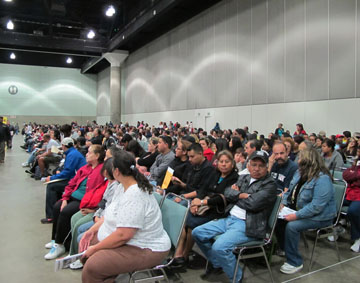
Homebuyers wait for assistance from NACA counselors
Armed with documents and lots of patience, thousands of homeowners braved the crowds and long waits at the L.A. convention center hoping the American Dream Home Save event would help them hold on to their homes.
For five days, Neighborhood Assistance Corporation of America (NACA) returned to Los Angeles to help struggling homeowners with the promise of providing them with a solution to their mortgage problems on site.
“The fear of being homeless is overwhelming. Having to pack up a house is like you’re packing up your dreams,” says Karen Johnson, who was at the convention center on Sunday to support an aunt who’s trying to stay in her South LA home.
Johnson, a special education teacher, is well aware of the frustrations of dealing with uncooperative banks. She almost lost her home after being laid off in 2009. She fell 18 months behind on her mortgage payments. During that period, she tried getting a loan modification, but she got no response from her original lender – Countrywide – and when Bank of America took over her loan, she says, she “got jerked around for a year…. I was in tears at times, with frustration,” she remembers.
“I think I was a victim. This was my American dream. I did so much to get this home. They weren’t going to get it without a fight.”
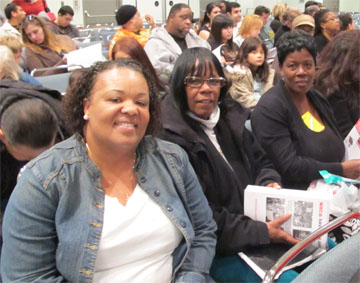
Karen Johnson (left) accompanied two aunts to a Home Save orientation session at the American Dream event on Sunday.
Johnson then heard of the NACA Home Save program. “They helped stop my foreclosure the same day.” That was in 2010. Although NACA helped her get a reduction in interest, her mortgage troubles aren’t over.
Johnson bought her house, located off Hoover and Imperial in South LA, in 2007 for $420,000. It’s now worth $239,000. “But I still owe like $500,000,” she complains. That’s because Countrywide originally set her up with a subprime interest only loan at 6.75 percent. For three years she paid a monthly mortgage of $2,500, just in interest, with nothing to the principal. In addition, the 18 months of missed payments were added back to her loan amount, she explains.
Although Johnson was able to get her interest rate reduced to 2 percent, her monthly mortgage payments are $1800. But she also has to pay $511 in private mortgage insurance (PMI). Lenders require buyers to pay for this usually high premium insurance if they put less than a 20 percent down payment towards a property purchase. PMI doesn’t protect or benefit the borrower. But it protects the lender against default on the loan.
When you add property taxes, Johnson is now paying over $2800 a month to keep her home. She’s hoping she’ll eventually be able to qualify for a principal loan reduction.
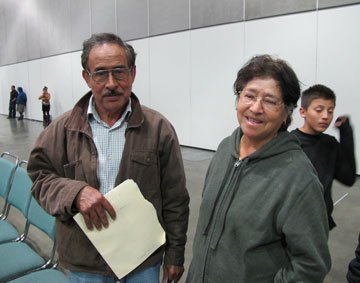
Retired couple Augusto and Rosa Avila are looking for lower interest rates for the home they’ve owned for more than 21 years in South Central LA.
Augusto and Rosa Avila are also worried about their home. The retired couple, who has been married 48 years, bought their South Central LA home in 1990 for $195,000. They’ve never been behind on their payments in the more than 20 years since they took out the loan. They’re paying $1,150 a month, but even that’s too much for them now that they’re on a lower fixed income.
“We prefer not to eat than to lose our home. What would we do without a home?” laments Rosa. “They told us when we bought the house that we would pay interest for 20 years and then only pay principal,” says Augusto in Spanish. “But I think they lied to us. We’re still paying 7 percent interest.”
The elderly couple spent over five hours at the convention center waiting for their turn to see a counselor. “We’re hoping we can get our interest reduced. Otherwise, we may start falling behind on our payments,” Rosa worries.
NACA has worked hard to get lenders to negotiate with distressed property owners. Rick Herrera, national media coordinator for the non-profit, says it hasn’t been easy. “Advocacy is among the best things NACA does. When CEO Bruce Marks started seeing thousands of foreclosures, he started talking to lenders about the need to restructure loans, but they refused…. We started disrupting shareholder meetings, showing up at the gated communities where the bank CEOs lived…. We made so much noise that we forced the banks to enter agreements with us.”
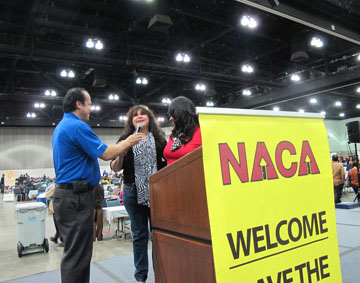
While Rick Herrera, national media coordinator for NACA, holds the mic for her, a woman shares news that NACA and BofA helped save her home.
During the American Dream Home Save events, people first get a 45 minute orientation, then they are matched with counselors who help them review their income and expenses and help them submit modification requests, and then arrange for the homeowner to meet with their lender.
Hundreds of counselors, underwriters and bank representatives were on hand from 8 am to 8 pm each day to help people on the verge of foreclosure or seeking loan modifications that would lower their monthly payments and allow them to stay in their homes.
NACA’s arrangement with the participating lenders is that they must provide a solution on site. Herrera says that if the homeowner comes prepared with all the required documents, there is an 80 to 85 percent resolution rate.
Whistles and horns sounded off throughout the day whenever a homeowner got a positive resolution, followed occasionally by rounds of clapping from other hopefuls waiting their turns. Some homeowners were able to keep their homes, but others walked away disappointed that there was nothing that could be done to help them.
While most of the people at the convention center were there to save their homes, many others were hoping to buy into the American Dream of owning one.
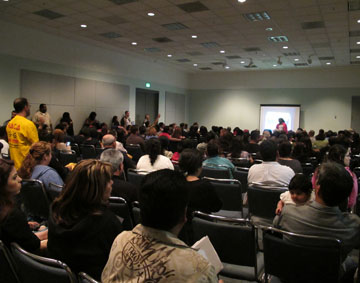
Homebuyers attend an orientation.
NACA also offers a home purchasing program. Prospective buyers have to go through an orientation session. They are then paired with a counselor who will help get them started on the qualifying process and let the potential homebuyer know “how much house they can afford.” The counselor sets them up with a lender (they only work with Bank of America or Citi Mortgage) and they are sent to a certified NACA realtor to find a home.
“We showed the banks we were better underwriters than they were,” says Herrera. “We showed them we were effective. Loans we underwrite have low rates of default.”
Herrera says NACA has organized 64 American Dream events around the country since 2009. Another 42 are scheduled for 2012.









 When Operation Hope started its mortgage crisis hotline in 2008, counselors logged more than 7,000 calls within the first 24 hours.
When Operation Hope started its mortgage crisis hotline in 2008, counselors logged more than 7,000 calls within the first 24 hours. 






